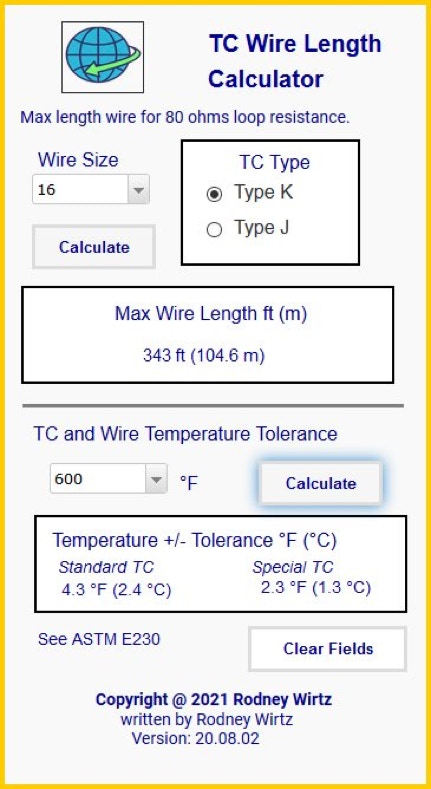Thermocouple Wire Max Length

Webapp’s QR code to scan with phone.

A thermocouple is a sensor for measuring temperature, that consists of two dissimilar metals that are joined together at the sensing end. Different thermocouple types (e.g. J, K, T, E, etc) use different mixtures of metals in the wire. At the wire’s end, the millivolt signal, provided by the thermocouple, represents its temperature.
Standard vs SLE (special limits of error) wire has to do with accuracy of the wire. SLE wire is the same as standard wire with the added feature of having a little better accuracy spec. Accuracy of thermocouples vary with thermocouple types. e.g. For the lower temperature ranges type T, composed of copper wire in the positive lead and constantan (copper-nickel mixture) for the negative, has good accuracy specifications.
Thermocouple grade wire is wire that is used to make the sensing point (or probe part) of the thermocouple. Extension grade wire is only used to extend a thermocouple signal from a probe back to the instrument reading the signal. The extension grade wire typically will have a lower ambient temperature limit in which the wire may be used. Namely, it may pass a signal representing a higher temperature as received from the probe, but the wire physically may not be exposed to higher temperatures. Thermocouple wire may be used as extension wire, but extension grade wire may not be used in the sensing point (or probe part) of the thermocouple.
There are many factors that can impact the usable length of a thermocouple. As a guideline, under 100 feet with 20 AWG or thicker wire in an area free of electromagnetic interference usually is fine. Two of the main factors in determining useable thermocouple length are total loop resistance and preventing electrical noise getting into the signal. Because different thermocouple wires are made of different materials, the resistance will vary based on the type as well as the wire diameter and length.
The allowable loop resistance is affected by the input resistance of the amplifier circuit to which it is attached. But as a guideline, typically the objective is to keep the total loop resistance under 100 ohms. Loop resistance is determined by multiplying the length in feet by the resistance per double feet (remember 1 foot length of run includes 1 foot from each of the two t/c wires). Remember in your calculations to include the probe (when used/applicable) in addition to the wire length. The second major factor in running a thermocouple wire is to keep it away from any electromagnetic fields. Thermocouple wire creates a low voltage signal and should not be run near power wires, motors, etc. To help minimize noise pickup, a metal over braid or twisted shielded wire is commonly used.
